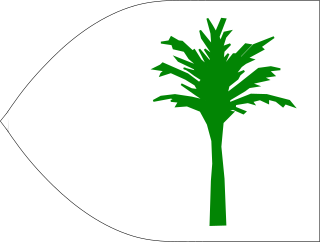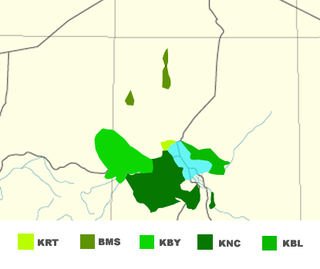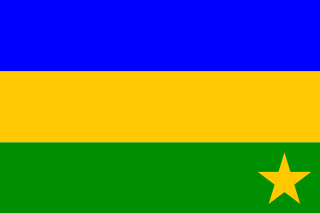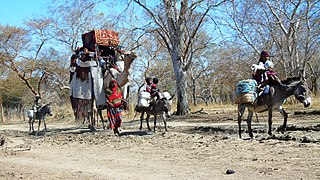
Hausa is a Chadic language that is spoken by the Hausa people in the northern parts of Nigeria, Ghana, Cameroon, Benin and Togo, and the southern parts of Niger, and Chad, with significant minorities in Ivory Coast. A small number of speakers also exist in Sudan.

The Kanem–Bornu Empire existed in areas which are now part of Nigeria, Niger, Cameroon, Libya and Chad. It was known to the Arabian geographers as the Kanem Empire from the 8th century AD onward and lasted as the independent kingdom of Bornu until 1900.

Kanuri is a Saharan dialect continuum of the Nilo–Saharan language family spoken by the Kanuri and Kanembu peoples in Nigeria, Niger, Chad and Cameroon, as well as by a diaspora community residing in Sudan.

The Kanuri people are an African ethnic group living largely in the lands of the former Kanem and Bornu Empires in Niger, Nigeria, Chad, and Cameroon. As well as a diaspora community residing in Sudan. Those generally termed Kanuri include several subgroups and dialect groups, some of whom identify as distinct from the Kanuri. Most trace their origins to ruling lineages of the medieval Kanem-Bornu Empire, and its client states or provinces. In contrast to the neighboring Toubou or Zaghawa pastoralists, Kanuri groups have traditionally been sedentary, engaging in farming, fishing the Chad Basin, trade, and salt processing.
Mao is a city in Chad, the capital of the Kanem Region and of the department also named Kanem. It is the 16th most populous city in Chad, and is located 226 km (140 mi) north-northeast of N'Djamena.

Daza is a Nilo-Saharan language spoken by the Daza people inhabiting northern Chad and eastern Niger. The Daza are also known as the Gouran (Gorane) in Chad. Dazaga is spoken by around 700,000 people, primarily in the Djurab Desert region and the Borkou region, locally called Haya or Faya-Largeau northern-central Chad, the capital of the Dazaga people. Dazaga is spoken in the Tibesti Mountains of Chad, in eastern Niger near N'guigmi and to the north. It is also spoken to a smaller extent in Libya and in Sudan, where there is a community of 3,000 speakers in the city of Omdurman. There's also a small diaspora community working in Jeddah, Saudi Arabia.

Hadjer-Lamis is one of the 23 regions of Chad, located in the southwest of the country. Its capital is Massakory. It corresponds to part of the former prefecture of Chari-Baguirmi and parts of N'Djamena.

The Bilala or Bulala are a Muslim people that live around Lake Fitri, in the Batha Prefecture, in central Chad. The last Chadian census in 1993 stated that they numbered 136,629 people. Their language, Naba, is divided in four dialects and is a part of the Central Sudanic language family; it is shared by two of their neighbours, the Kuka and the Medogo. These three peoples are collectively known as Lisi and are believed to be descendants of main ethnic groups of the Sultanate of Yao.
Marba is an Afro-Asiatic language spoken by the Azumeina peoples of Chad as their first language. It is also the name of one of the Azumeina peoples.
Zaghawa is a Nilo-Saharan language spoken by the Zaghawa people of east-central Chad and northwestern Sudan (Darfur). The people who speak this language call it Beria, from Beri, the endonym of the Zaghawa people, and a, Zaghawa for "mouth". It has been estimated that there are about 447,400 native speakers of the Zaghawa language, who primarily live in Chad and the Darfur region of Sudan. It is also spoken by a smaller number of speakers in Libya.
The Fula language is written primarily in the Latin script, but in some areas is still written in an older Arabic script called the Ajami script or in the recently invented Adlam script.
Mpadə is an Afro-Asiatic language spoken in northern Cameroon and southwestern Chad. Dialects are Bodo, Biamo, Digam, Mpade (Makari), Shoe (Shewe), and Woulki.
Bidiyo is an Afro-Asiatic language spoken in south central Chad.
Sokoro is an Afro-Asiatic language spoken in central Chad. Dialects are Bedanga and Sokoro. Speakers make up the majority of the population of Gogmi Canton in Melfi, Chad.
Mokilko, or Mukulu, is a Chadic language spoken in central Chad. The local name for the language is Gergiko. This is the name used for mother-tongue literacy materials. Mukulu is the name of a village.

The population of Chad has numerous ethnic groups. SIL Ethnologue reports more than 130 distinct languages spoken in Chad.
Maba is a Nilo-Saharan language of the Maban branch spoken in Chad and Sudan. It is divided into several dialects, and serves as a local trade language. Maba is closely related to the Masalit language. Most speakers of Maba reside in Chad with 542,000 speakers as of 2019. In 2022 there were 28,000 speakers in Sudan where the language is known as Sulaihab.
Sar or Sara, also known as Madjingay and Sara Madjingay is a Bongo–Bagirmi language of southern Chad, and the lingua franca of regional capital of Sarh.
Adamawa Fulfulde is a variety of the Fula language. It is spoken mainly in Cameroon but also by significant communities residing in Nigeria, Chad, and Sudan by Fulani pastoralists across the Sahel. It is also known as Eastern Fulfulde and by various other names including Boulbe, Dzemay, Fula, Fulfulde, Mbororo, Palata, Peul etc.









